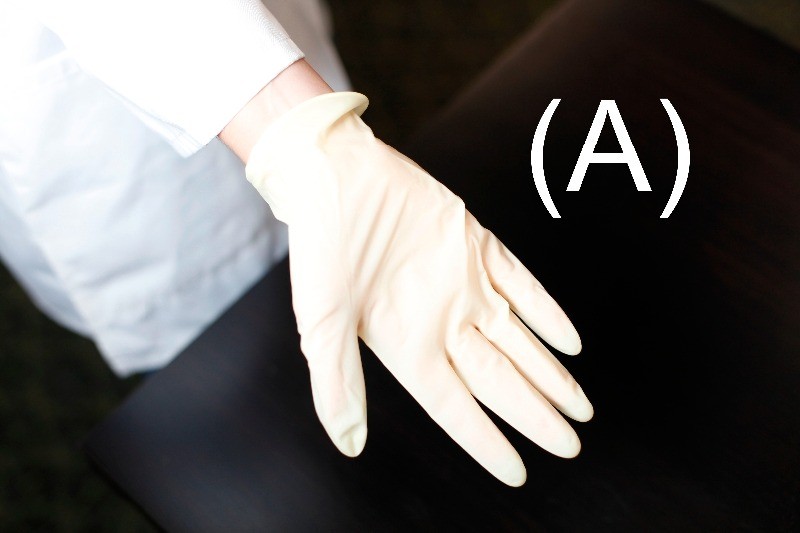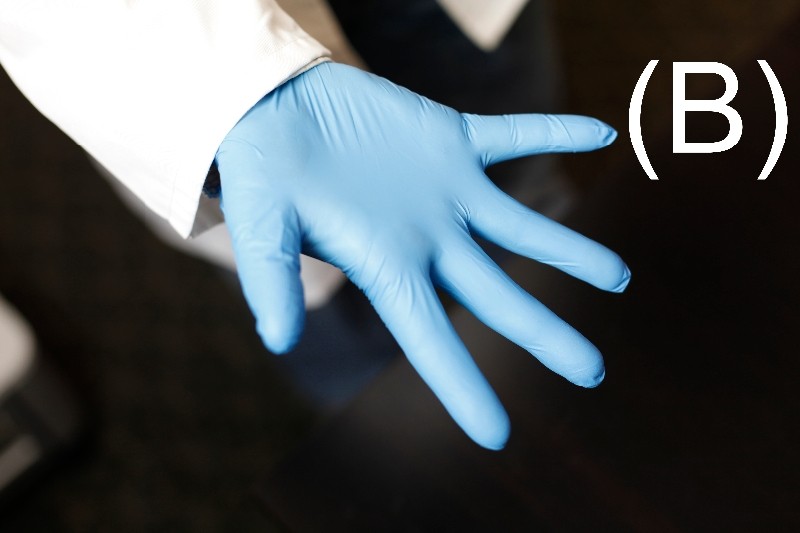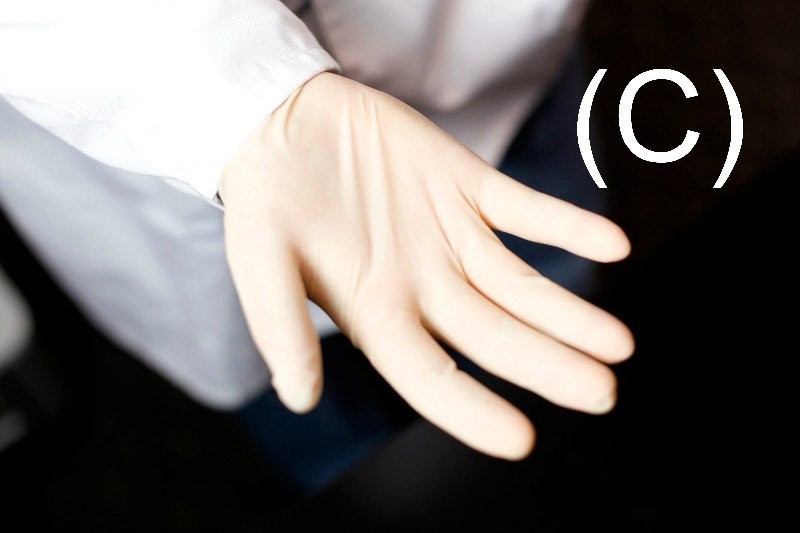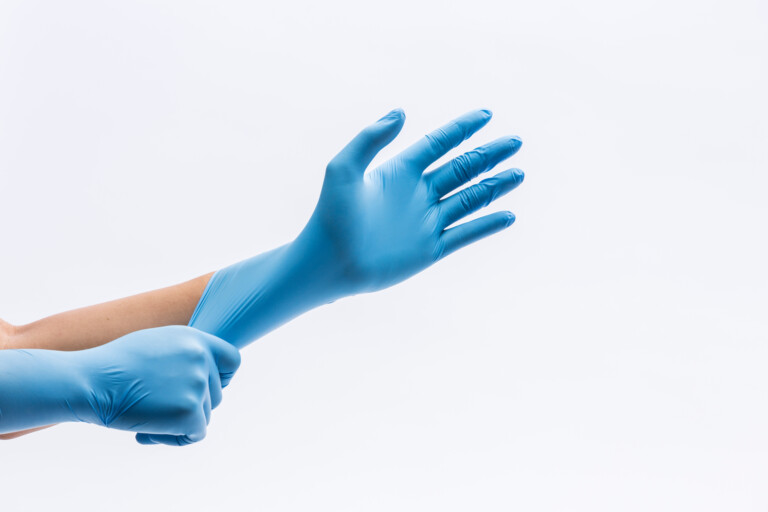As dental professionals—dentists, hygienists, specialists, and office managers—your commitment to patient safety is paramount. One critical aspect of this safety is wearing appropriately sized exam gloves during routine exams; procedures such as root canals, tooth removal, and placing implants; and imaging, x-rays, and intraoral scans.
Ill-fitting gloves can compromise safety and hinder your performance. You are putting on and removing gloves dozens of times each day, so the wrong glove can have a consistent negative impact on health and safety. Prioritize proper sizing to ensure both safety and comfort in your dental practice.
Are You Wearing the Right Sized Glove?
The images below indicate a pair of exam gloves that are (A) too loose, (B) too tight, and (C) a good fit. If the exam gloves are too big, they can easily be pulled off or liquids can make their way inside the glove. This can also be distracting to the wearer.
On the other hand, if the exam gloves are too tight, it can cause fatigue, decrease dexterity, and increase irritation.



Wearing gloves that fit properly is essential to ensure that they provide the best protection. Here are some tips to help you ensure that your medical gloves fit your hands correctly:
How to Correctly Fit A Glove
Gloves are a foundational part of your day-to-day practice, which makes choosing a correct fit essential. There are several variables that affect how gloves fit your hands that can make a good glove a truly effective tool.
1. Glove Length
The length of a glove is measured from the tip of the middle finger to the cuff. Exam gloves are usually at least 9 inches long, while surgical gloves and some cleanroom gloves are 12 inches long to provide more protection.
2. Glove Width:
The width of a glove is important for proper fit. Gloves are made to specific standards, but there is a wide range within each size. For example, a medium exam glove can vary from 85mm to 105mm in width. One manufacturer’s “medium” glove could be another manufacturer’s “large” glove.
3. Finger Length and Width:
Finger lengths and widths vary between product lines from different manufacturers. The glove material affects the amount of stretch, which affects finger fit. A super stretchy, low protein latex glove works with the widest range of finger sizes, and could be a good choice for individuals with shorter fingers. Nitrile gloves have different levels of stretch, which affects finger fit.
4. Glove Material:
Glove thickness and stretchability also affect overall glove fit. If you’re used to wearing a “medium” glove in one brand, you may need to try a “small” or a “large” glove in another brand. If you’re trying a very thin glove, you may need to try a smaller size to get the proper fit.
5. Finger Contour:
Surgical gloves have contoured fingers and a natural thumb position for the best fit, but they cost more than exam gloves. Ambidextrous nitrile exam gloves (gloves that can be worn on the left or right hand) are a more affordable option.
Steps to the Perfect Fit
1. Measure the Circumference of Your Dominant Hand:
Your dominant hand is the key factor when selecting the right glove size. The size of your dominant hand will determine the glove size you need. Measuring your hand correctly is essential to ensure you get the best fit. Start by measuring your dominant hand’s circumference around the knuckles, excluding your thumb. Use a measuring tape to get the most accurate measurement. Once you have your measurement, refer to a glove size chart to find your size.

2. Take Another Measurement From the Tip of Your Middle Finger:
While referring to your dominant hand as the main factor in determining your glove size is fine, you should also take another measurement from the tip of your middle finger. This will help you get a better fit, as the size of your middle finger can vary from your knuckles.
To measure your middle finger, hold it straight and measure from the tip of your finger to the base of your palm. Once you have your measurement, refer to the glove size chart again and select the size that best fits your measurements.
3. Try on a Few Gloves From Different Manufacturers:
Every medical supplies manufacturer has varying sizes, so trying on a few different gloves from different manufacturers is important to find the one that fits you best. This way, you can ensure the gloves provide the best fit and comfort. You can also ask these manufacturers for a copy of their glove sizing chart to compare the measurements and ensure you get the right size.
4. Check the Glove’s Thickness:
The glove’s thickness is also a vital factor to consider when selecting medical gloves. Thicker gloves provide more protection, but they can also reduce dexterity and tactile sensitivity. Thinner gloves provide better dexterity and tactile sensitivity, and they can offer the same amount of protection as a thick glove—as long as they don’t break. Thinner gloves are a common choice in dentistry because of the tactile responsiveness. The key to effective use of a thinner glove is to ensure that it fits correctly to minimize any risk of breakage.
Final Fit Considerations
Once you have selected the right size and type of glove, it’s important to ensure that you are wearing them correctly. Here are some tips to help you wear your gloves properly:
1. Thoroughly Wash Your Hands Before Putting Gloves On:
Before putting on your gloves, make sure to wash your hands thoroughly with soap and water. This will help reduce the risk of infection. Some gloves, like natural extensions® nitrile Slide™, are specially designed to go on easily over damp hands, making the process of taking them on and off 50% faster and easier.
2. Select the Appropriately Sized Gloves:
Always select gloves that fit properly. Gloves that are too small can tear or rip, while gloves that are too large can slip off or reduce dexterity. One size does not fit all: if any staff at your practice have very small hands, make sure you have extra small gloves to properly fit them.
3. Pull Glove Cuff Towards Wrist to Cover as Much Skin as Possible:
When putting on your gloves, make sure to pull the cuff towards your wrist to cover as much skin as possible. This will help reduce the risk of exposure to contaminants.
Wrapping It Up
Wearing gloves that fit properly is essential to ensure that they provide the best protection. By following these tips, you can ensure that your medical gloves fit your hands correctly and provide the best protection. Remember to always wear gloves when performing medical procedures and to follow proper hand hygiene practices to reduce the risk of infection.
To learn more about gloves, the science of glove materials, and how fit and feel impact performance, visit Benco Dental U, or click here to find out what gloves are a fit for you and get matched with the perfect gloves for your needs.


